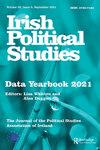Is a middle force emerging in Northern Ireland?
IF 1.1
4区 社会学
Q3 POLITICAL SCIENCE
引用次数: 4
Abstract
ABSTRACT Analysis of the flow of demographic trends and the evolution of political forces in Northern Ireland has long had a predominantly binary focus. The many studies of the fall and rise of nationalism, and of the rise and fall of unionism, are based on a sometimes explicit but more often unspoken narrative of competition between two communities. This article considers an issue in relation to which a much smaller literature has appeared: the steady growth of an apparent middle ground. This is made up in part of those who were born outside Northern Ireland. But it also includes people who have exited from affiliation to the two dominant communities defined by religious background, or perhaps never belonged to either; of those who do not see themselves unambiguously as British or as Irish, but rather report a dual or alternative identity; and of those who identify with neither the unionist nor the nationalist community. Using census and survey data, the article tracks the evolution of this expanding section of the population, and assesses its implications for political choice and for the future constitutional path of Northern Ireland.北爱尔兰正在兴起一股中间力量吗?
长期以来,对北爱尔兰人口趋势流动和政治力量演变的分析一直是一个主要的二元焦点。许多关于民族主义的兴衰,以及联合主义的兴衰的研究,都是基于对两个社区之间竞争的一种有时是明确的,但更多时候是不言而喻的叙述。这篇文章考虑了一个相对较小的文献已经出现的问题:一个明显的中间立场的稳定增长。这部分是由出生在北爱尔兰以外的人组成的。但它也包括那些脱离了由宗教背景界定的两个主要群体,或者可能从未属于过其中任何一个群体的人;他们并不明确地认为自己是英国人还是爱尔兰人,而是认为自己有双重或另类身份;以及那些既不认同统一派也不认同民族派的人。本文利用人口普查和调查数据,追踪了这一不断扩大的人口部分的演变,并评估了其对政治选择和北爱尔兰未来宪法道路的影响。
本文章由计算机程序翻译,如有差异,请以英文原文为准。
求助全文
约1分钟内获得全文
求助全文

 求助内容:
求助内容: 应助结果提醒方式:
应助结果提醒方式:


